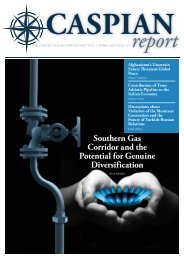Create successful ePaper yourself
Turn your PDF publications into a flip-book with our unique Google optimized e-Paper software.
porter, importing about 55% of their<br />
energy supply-approximately 84%<br />
of their oil and 64% of their natural<br />
gas. Fifteen EU member states are<br />
increasingly reliant on natural gas,<br />
in order to reduce carbon dioxide<br />
and greenhouse gas emissions. 5 As<br />
the European demand for gas is unlikely<br />
to decrease, 6 a huge bulk of European<br />
energy imports are expected<br />
to come from the three major gas<br />
suppliers of Europe, namely Norway,<br />
Algeria, and Russia. 7 Approximately<br />
30% of the EU’s net gas consumption<br />
is provided by Russia. 8 In 2012, Russia<br />
accounted for 34% of European<br />
natural gas imports, surpassed by<br />
Norway as the lead supplier. Algeria<br />
is the third-largest supplier to the<br />
EU. 9 However, even though there are<br />
other suppliers, it seems that Europe<br />
will still remain extremely vulnerable<br />
to Russian control over gas supplies.<br />
As stated by The Economist,<br />
while 10 billion cubic metres (bcm)<br />
could come from Norway, the scope<br />
for further production inside the EU<br />
would remain limited. For instance,<br />
in the Netherlands public opinion<br />
would demand the country to pump<br />
less gas, not more. Britain’s gas fields<br />
- due to depletion - would further offer<br />
no better option. Moreover, North<br />
Africa has “proved an unreliable<br />
supplier, beset by terrorist threats<br />
and other unrest.” Italy’s imports<br />
from Libya are also described as a<br />
weak option; supplies were down by<br />
11.9% in 2013. Supplies from Algeria<br />
were down by a full 40%. 10<br />
5.<br />
The European Commission forecasts that EU will import over 80% of its natural gas needs by<br />
2030. Europe’s Energy Security: Options and Challenges to Natural Gas Diversification, CRS,<br />
August 2013, P. 5,<br />
59<br />
CASPIAN REPORT, FALL <strong>2014</strong><br />
6.<br />
International Energy Outlook 2013, US Energy Information Administration, http://www.eia.<br />
gov/forecasts/ieo/nat_gas.cfm, see also “Recent trends in the Global Energy Oil & Gas<br />
Economy”, IISS – Oberoi Lecture, IISS, 14 August <strong>2014</strong>, http://www.iiss.org/en/events/events/<br />
archive/2013-5126/august-1e98/recent-trends-in-global-energy-1218<br />
7.<br />
Europe’s Energy Security: Options and Challenges to Natural Gas Diversification, CRS, August<br />
2013, P. 5, http://fas.org/sgp/crs/row/R42405.pdf<br />
8.<br />
Clingendael International Energy Programme, Factsheet, p.1, 2, http://www.clingendaelenergy.<br />
com/files.cfmevent=files.download&ui=9C1DEEC1-5254-00CF-FD03186604989704<br />
9.<br />
Europe’s Energy Security: Options and Challenges to Natural Gas Diversification, CRS, August<br />
2013, P. 5, http://fas.org/sgp/crs/row/R42405.pdf<br />
10.<br />
“Conscious uncoupling”, European energy security, The Economist, Apr 5th <strong>2014</strong>, see also<br />
http://www.eia.gov/forecasts/ieo/nat_gas.cfm










